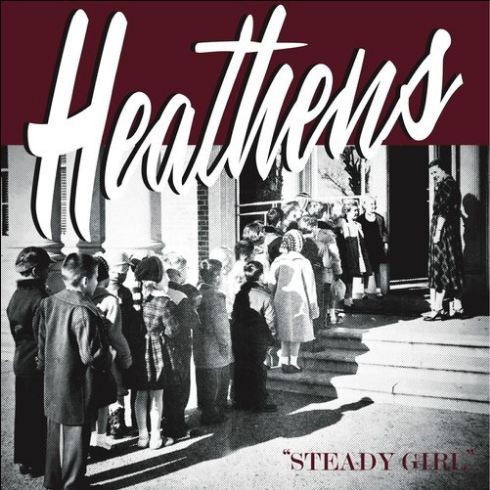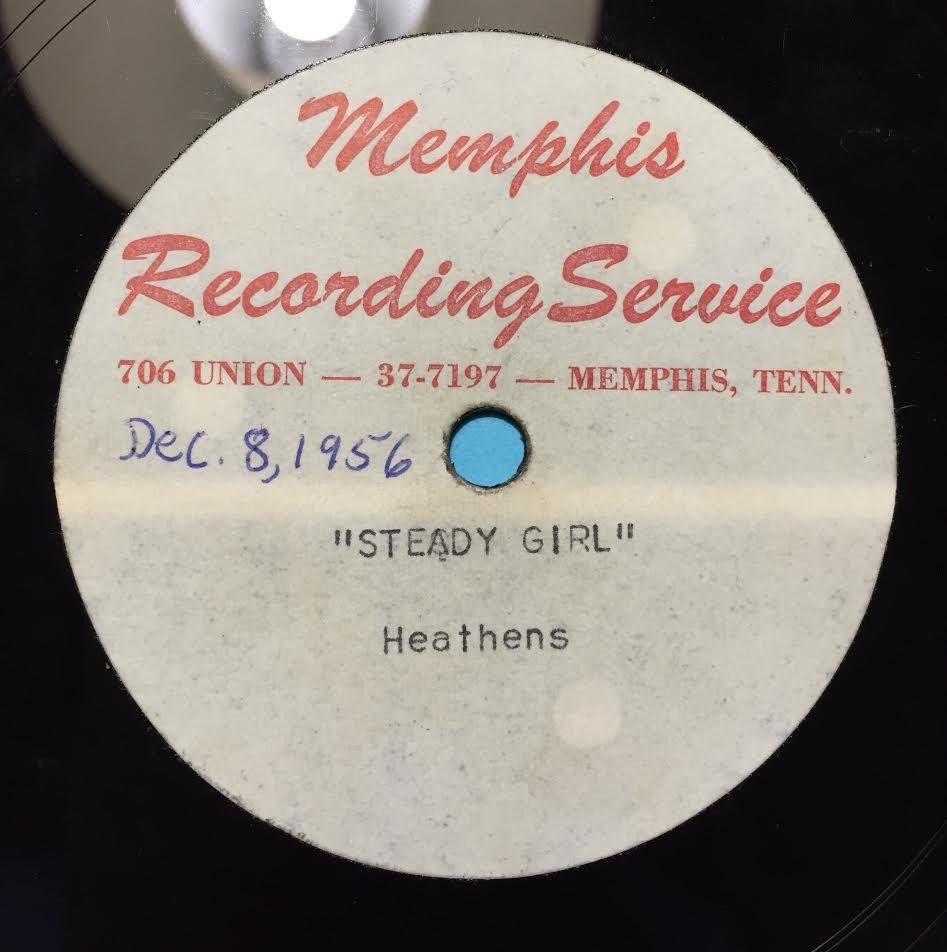
Just imagine being a sheltered teen in Memphis, ca. 1956, never having heard of pizza. A shy girl who nonetheless has her antennae out and a good ear for music; holed up at home with your new Fender electric guitar. Around the city, rock ‘n’ roll is buzzing. In fact, it may have already peaked. Writer Nick Tosches, in hindsight, famously pronounced it dead in 1954, but judging from the teen life of Kaye Garren, its heart was still beating two years later.
Much has been written of Garren’s life lately, thanks to the unearthing of a Memphis Recording Service acetate by local collector Frank Bruno. Marked “Dec. 8, 1956/’Steady Girl’/Heathens,” It features co-writer Garren on guitar, and her then-sweetheart Colin Heath singing the words he wrote. With Joe Bauer on drums, Roger Fakes on lead guitar, and David Gibson on piano, they comprised the Heathens, And their acetate, a one of a kind gem never pressed up as a Sun Records release, stands as a time capsule of a time when rock ‘n’ roll reigned.
 Frank Bruno
Frank Bruno
The story of the recording’s discovery, and the moment when Garren heard it again for the first time in 62 years, is beautifully documented by John Beifuss of the Commercial Appeal. And that story in turn points readers to Garren’s memoir of that era, before and after the sweethearts popped into Sam Phillips’ recording studio to immortalize their sound.
Her memoir, written only a month before she succumbed to pulmonary disease, helps contextualize the recording and is essential reading for anyone interested in the Memphis scene of the time. In fact, it’s gripping in its own way, and one can only hope that illustrator Mike McCarthy turns it into a graphic novel one day. As it is, the memoir sets the scene for the sounds in the grooves, now released as a ’45 (including two takes of “Steady Girl”) by Black & Wyatt Records, and celebrated tonight at a record release party at the B-Side bar.
And what of the sound within? Bruno has dubbed his discovery the “the first garage rock recording of all time,” a tall claim indeed. But even if other rockabilly and rock ‘n’ roll sides had been cut for many years before, in the very same professional facility, the spirit of the Heathens’ demo is indeed garagey, pre-figuring unhinged sounds that would not gain currency and fans until a decade or more later.
The sound of this hot rockabilly mess is immediate. You sense the room around the microphone, the natural sound of the room at Sun, and all the sonic thrashing that five teenagers could muster. In It Came from Memphis, Robert Gordon writes of his then-girlfriend referring to bands in the 1980s Antenna Club scene as “car crash music, likening it to a wreck on the highway that makes you slow down as you pass, gawking.” If that is one of the many “Memphis Sounds,” this record is its grandmother. Indeed, it embodies the spirit of happy accidents and unhinged passion that auteurs like Jim Dickinson, Alex Chilton, and Tav Falco became enamored of in that later age.
The band rolls and tumbles with abandon, all the more powerfully for their lack of adherence to norms of tempo and phrasing. And, though 1956 had already seen the release of singles by rockabilly greats Cordell Jackson and Wanda Jackson, Garren’s chopping strum really is groundbreaking. Not only was she “the only girl who had an electric guitar and played rock and roll” at East High School, she was one of the few in the business.
This disregard for middling conventionality is carried by the rest of the band as well. Perhaps the greatest irony of this recorded moment is that it’s the drummer, Joe Bauer, who went on to play professionally, eventually with 60s hit-makers the Youngbloods. Here, over ten years earlier, his playing is the most unhinged of all, flying off at untethered tempos during the solo and throughout the song as his passions demanded.
Singer Colin Heath carries the lyrics, which he penned in Garren’s honor, with earnest furor. Reading of how Sam Phillips’ son would exclaim to his father (about John Prine), “Dad, this guy sings so bad, you’ll love him!” in It Came from Memphis, it’s almost a surprise that Sam Phillips did not release this track. In a way, they convey the somewhat surreal aesthetic of classic Harmonica Frank Floyd, for whom Sun recorded many sides.
In any case, the acetate sat for decades until now, as its performers moved on with their lives. Though Garren and Heath eventually divorced, they lived an idyllic beatnik life into the late sixties. Garren’s memoir describes their times during and after the recording session, as friends and colleagues of young Jim Dickinson in their common pursuit of folk music and theatrical mayhem. Indeed, for living the free spirited folk life, even as they raised three young children, they were well ahead of the cultural curve, having already sung for years as a duo and toured in a VW bus, before giving up on both music and their marriage by 1967.
As a lesson in how these homespun auteurs raged ahead with a shambolic passion, prefiguring the wider rebellion of the next decade to come, listen to this record. Read Garren’s words. And marvel at this newly discovered instance of rock ‘n’ roll liberation.